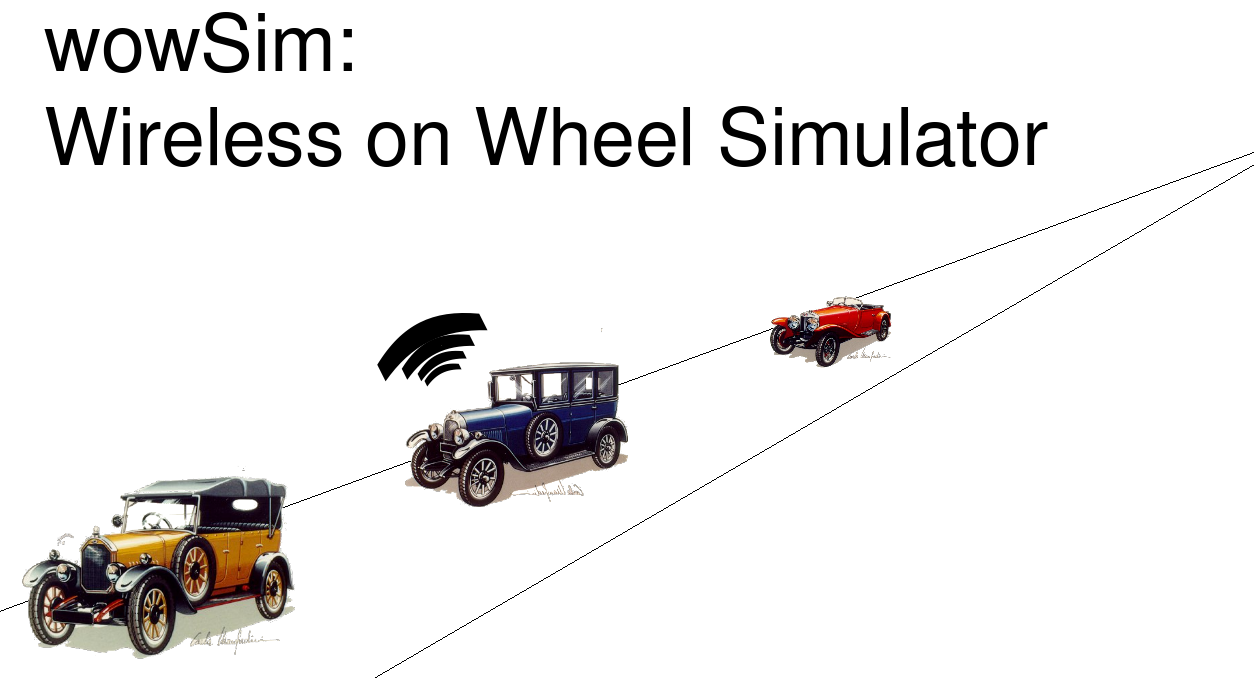Important
Starting November 2018, I am on extended academic leave. This website, as well as contact information, etc. are no longer up-to-date. Please check https://nonsns.github.io for more information
Information!
this page has archaeological (but no longer scientific) interest

Source code
Download the latest version of ‘'’wowSim’’’ (v0.75), an event driven C simulator for Vehicular Area Networks (VANETs) implementing 802.11-like medium access protocol and a realistic description of vehicular dynamics (based on Cellular Automata and Coupled Maps) and several other features.
- wowSim-0.75.tgz
- wowSim is released under GPL licence, see the disclaimer in the source code for futher details.
- wowSim makes use of ‘‘libghthash’’ (included in the tarball, see http://www.ipd.bth.se/ska/sim_home/libghthash.html for further info)
Usage
wow-0.75 (ICC'08 flavor)
usage:
wow [general opt] [traffic opt] [channel opt] [algorithm opt]
where:
----[general options]---------------------------------------
-D: debug flag - a debug file (\"debug.out\") is created in
the directory "debug"
-?: help - the available options are displayed
-T: test mode (use all defaults values, useful to sneak SEGV)
-f: force to overwrite existing files
-O: use output "dir" rather than default one
-C: quit after "num" cycles
by default, simulation terminates when networking
performance converges; however, to study traffic
dynamic, a lower cycles number may be sufficient
----[traffic model options]---------------------------------------
-t: traffic model {0:Poisson, 1:NaSch, 2:NaSch-(muSTEP),
3:Gipps(*),4:Gipps-(muSTEP),
4:VDR, 6:VDR-(muSTEP),
7:Tsquare, 8:Tsquare-(muSTEP),
9:Fukui, 10:Fukui-(muSTEP),
11:TOCA}
-R: [realistic models] vehicles'density [vehs/km]
-l: [Poisson] vehicles'arrival rate
-v: [Poisson] speed pdf {unif|cost|exp}
-n: [Poisson] new cars arrival period after the accident(min)
-s: [Poisson] time between consecutive broadcast cycles (min)
----[channel model options]---------------------------------------
-c: channel model {0:ErrorFree, 1:Bernoulli, 2:Transitional, 3:Gilbert}
-x: parameter "x" meaning depend from the channel_model:
CHANNEL_BERNOULLI: parameter "x" = loss probability
CHANNEL_TRANSITIONAL: parameter "x" = channel.transition
----[algorithmic options]-----------------------------------------
-a: algorithm (none|optimum|pflood|d2flood|help|hybrid|d3flood)
-r: vehicles transmission range (m)
-P: [pflood] flooding probability
-k: [d2flood] k power
-2: [d2flood] d2flood rule number
-h: [d3flood] h power
-3: [d2flood] d3flood rule number
-B: [help] Average Beacon Transmission Interval (sec)
-e: [help] "epsilon" fixed error margin (m)
-E: [help] rule number for adaptive margin
-y: parameter "y" meaning depend from the algorithmic context:
ALGO HYBRID: hybridation type (see help.c)
-H: [hybrid] Hybridity degree in [0,1], with 0="help
use -y to tune behavior (see help.c)
note:
at least one arg should be specified; for all the others,
their default value will be selected
IMPORTANT:
directory debug must exist (even in non-debug mode)
otherwise SEGV will be raised
References
-
[WILEY-10]
Rossi, D. and Fracchia, R. and Meo, M.,
On the quality of broadcast services in vehicular ad hoc networks In Wiley Security and Communication Networks Journal, Special Issue on QoS Assured Wireless and Mobile Networks, . 2010, journal@article{DR:WILEY-10, author = {Rossi, D. and Fracchia, R. and Meo, M.}, title = {{On the quality of broadcast services in vehicular ad hoc networks}}, journal = {Wiley Security and Communication Networks Journal, Special Issue on QoS Assured Wireless and Mobile Networks}, year = {2010}, month = {}, howpublished = {https://perso.telecom-paristech.fr/drossi/paper/rossi10scnj.pdf} } -
[ICC-08]
Rossi, D. and Fracchia, R. and Meo, M.,
VANETs: Why Beaconing at All IEEE International Conference on Communications (ICC’08) may. 2008, conference@inproceedings{DR:ICC-08, author = {Rossi, D. and Fracchia, R. and Meo, M.}, title = {{VANET}s: Why Beaconing at All}, booktitle = {IEEE International Conference on Communications (ICC'08)}, address = {Beijing, China}, year = {2008}, month = may, howpublished = {https://perso.telecom-paristech.fr/drossi/paper/rossi08icc.pdf} } -
[SPRINGER-07]
Rossi, D. and Casetti, C. and Chiasserini, C.F.,
Some Study on Communication Performance @inbook{DR:SPRINGER-07, author = {Rossi, D. and Casetti, C. and Chiasserini, C.F.}, booktitle = {Sensor Network and Configuration}, title = {Some Study on Communication Performance}, editor = {Ed., N.P. Mahalik}, publisher = {Springer-Verlag}, address = {Berlin, Germany}, year = {2007}, howpublished = {https://perso.telecom-paristech.fr/drossi/paper/MISSINGURL.pdf} } -
[AUTONET-06]
Fracchia, R. and Meo, M. and Rossi, D.,
VANETs: To Beacon or Not To Beacon Autonet’06 Workshop at IEEE Globecom’06 nov. 2006, conference@inproceedings{DR:AUTONET-06, author = {Fracchia, R. and Meo, M. and Rossi, D.}, title = {VANETs: To Beacon or Not To Beacon}, booktitle = {Autonet'06 Workshop at IEEE Globecom'06}, address = {San Francisco, CA, USA}, year = {2006}, month = nov, howpublished = {https://perso.telecom-paristech.fr/drossi/paper/rossi06autonet.pdf} } -
[MEDHOC-06]
Fracchia, R. and Meo, M. and Rossi, D.,
On the Impact of Traffic Models on Inter-vehicular Broadcast Communication IEEE MedHocNet 2006 jun. 2006, conference@inproceedings{DR:MEDHOC-06, author = {Fracchia, R. and Meo, M. and Rossi, D.}, title = {On the Impact of Traffic Models on Inter-vehicular Broadcast Communication}, booktitle = {IEEE MedHocNet 2006}, address = {Lipari, Italy}, year = {2006}, month = jun, howpublished = {https://perso.telecom-paristech.fr/drossi/paper/rossi06medhocnet.pdf} } -
[ASWN-06]
Fracchia, R. and Meo, M. and Rossi, D.,
Avoiding broadcast storms in inter-vehicular warning delivery services 6th International Workshop on Applications and Services in Wireless Networks (ASWN’06) apr. 2006, conference@inproceedings{DR:ASWN-06, author = {Fracchia, R. and Meo, M. and Rossi, D.}, title = {Avoiding broadcast storms in inter-vehicular warning delivery services}, booktitle = {6th International Workshop on Applications and Services in Wireless Networks (ASWN'06)}, address = {Berlin, Germany}, year = {2006}, month = apr, howpublished = {https://perso.telecom-paristech.fr/drossi/paper/rossi06aswn.pdf} } -
[MP2P-06]
Fracchia, R. and Meo, M. and Rossi, D.,
Knowing Vehicle Location HELPs Avoiding Broadcast Packets Storm 3rd IEEE International Workshop on Mobile Peer-to-Peer Computing (MP2P’06) at IEEE PerComm’06 mar. 2006, conference@inproceedings{DR:MP2P-06, author = {Fracchia, R. and Meo, M. and Rossi, D.}, title = {Knowing Vehicle Location HELPs Avoiding Broadcast Packets Storm}, booktitle = {3rd IEEE International Workshop on Mobile Peer-to-Peer Computing (MP2P'06) at IEEE PerComm'06}, address = {Pisa, Italy}, year = {2006}, month = mar, howpublished = {https://perso.telecom-paristech.fr/drossi/paper/rossi06mp2p.pdf} }